右脑英语
- 格式:docx
- 大小:24.67 KB
- 文档页数:7
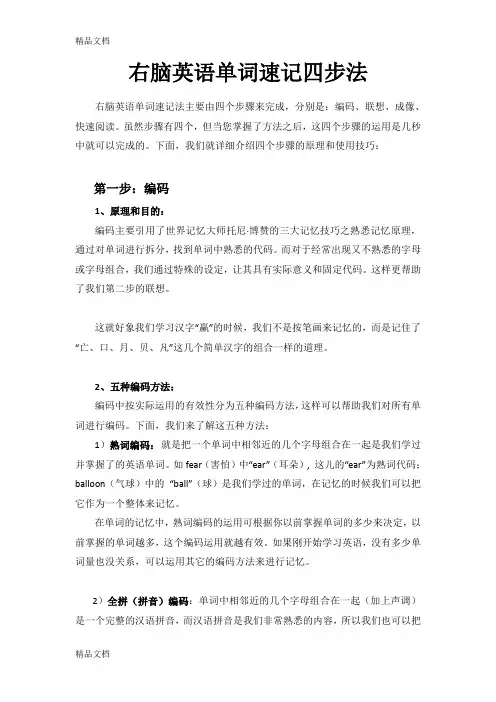
右脑英语单词速记四步法右脑英语单词速记法主要由四个步骤来完成,分别是:编码、联想、成像、快速阅读。
虽然步骤有四个,但当您掌握了方法之后,这四个步骤的运用是几秒中就可以完成的。
下面,我们就详细介绍四个步骤的原理和使用技巧:第一步:编码1、原理和目的:编码主要引用了世界记忆大师托尼·博赞的三大记忆技巧之熟悉记忆原理,通过对单词进行拆分,找到单词中熟悉的代码。
而对于经常出现又不熟悉的字母或字母组合,我们通过特殊的设定,让其具有实际意义和固定代码。
这样更帮助了我们第二步的联想。
这就好象我们学习汉字“赢”的时候,我们不是按笔画来记忆的,而是记住了“亡、口、月、贝、凡”这几个简单汉字的组合一样的道理。
2、五种编码方法:编码中按实际运用的有效性分为五种编码方法,这样可以帮助我们对所有单词进行编码。
下面,我们来了解这五种方法:1)熟词编码:就是把一个单词中相邻近的几个字母组合在一起是我们学过并掌握了的英语单词。
如fear(害怕)中“ear”(耳朵), 这儿的“ear”为熟词代码;balloon(气球)中的“ball”(球)是我们学过的单词,在记忆的时候我们可以把它作为一个整体来记忆。
在单词的记忆中,熟词编码的运用可根据你以前掌握单词的多少来决定,以前掌握的单词越多,这个编码运用就越有效。
如果刚开始学习英语,没有多少单词量也没关系,可以运用其它的编码方法来进行记忆。
2)全拼(拼音)编码:单词中相邻近的几个字母组合在一起(加上声调)是一个完整的汉语拼音,而汉语拼音是我们非常熟悉的内容,所以我们也可以把它作为一个整体来记忆。
如change(改变)中“chang”加上声调就是“嫦”的拼音,“e”加上声调就是“娥”的拼音;check(检查)这个单词中“che”加上声调就是“车”的拼音。
这样的拼音就是我们的全拼代码。
全拼编码的运用可根据你的汉语拼音的熟练程度来决定,只要你能在一个单词中找到拼音(几个字母组合),基本上就可以运用了,但有一点需要注意,如果这个拼音拼出的汉字意思特别抽象,尽量不要使用。
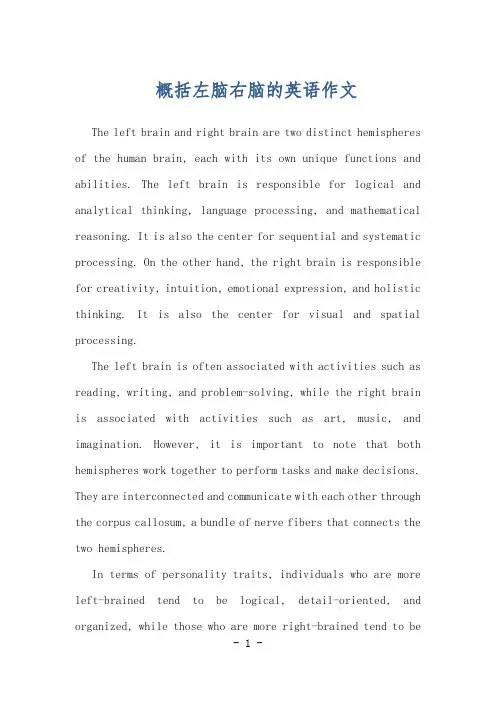
概括左脑右脑的英语作文The left brain and right brain are two distinct hemispheres of the human brain, each with its own unique functions and abilities. The left brain is responsible for logical and analytical thinking, language processing, and mathematical reasoning. It is also the center for sequential and systematic processing. On the other hand, the right brain is responsible for creativity, intuition, emotional expression, and holistic thinking. It is also the center for visual and spatial processing.The left brain is often associated with activities such as reading, writing, and problem-solving, while the right brain is associated with activities such as art, music, and imagination. However, it is important to note that both hemispheres work together to perform tasks and make decisions. They are interconnected and communicate with each other through the corpus callosum, a bundle of nerve fibers that connects the two hemispheres.In terms of personality traits, individuals who are more left-brained tend to be logical, detail-oriented, and organized, while those who are more right-brained tend to becreative, intuitive, and emotional. However, it is important to remember that everyone uses both hemispheres of the brain to some extent, and there is no such thing as being purely left-brained or purely right-brained.In conclusion, the left brain and right brain are both essential for human cognition and behavior. While they have different functions and abilities, they work together to help us navigate the world and make sense of our experiences.左脑和右脑是人脑的两个不同半球,每个半球都有自己独特的功能和能力。
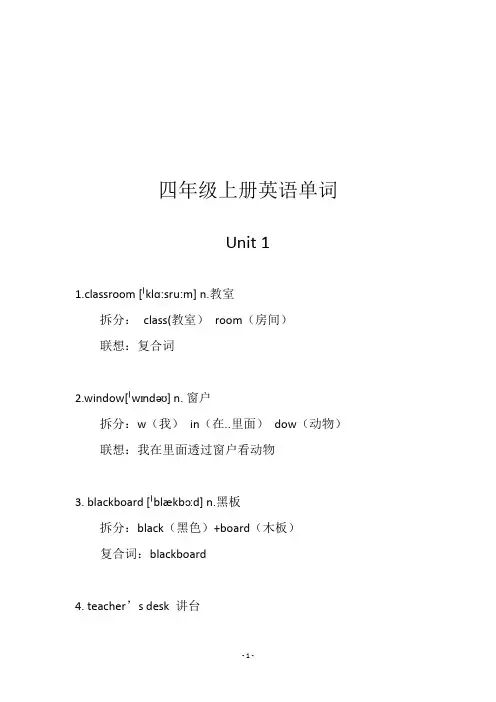
四年级上册英语单词Unit 11.classroom [ˈklɑ:sru:m] n.教室拆分:class(教室)room(房间)联想:复合词2.window[ˈwɪndəʊ] n. 窗户拆分:w(我)in(在..里面)dow(动物)联想:我在里面透过窗户看动物3. blackboard [ˈblækbɔ:d] n.黑板拆分:black(黑色)+board(木板)复合词:blackboard4. teacher’s desk 讲台5.light [laɪt] n.电灯拆分:lig(李刚)ht(后天)联想:李刚后天买电灯6. picture[ˈpɪktʃə(r)] n.图画拆分:pic(拼音:皮草)ture(真实的)联想:图画里的皮草是真实的7.door [dɔ:(r)] n.门拆分:d(弟弟) oo(两个鸡蛋) r(小草)联想:弟弟将两个鸡蛋和小草挂到了门上puter[kəmˈpju:tə(r)] n.计算机拆分:com(拼音:聪明)pu(拼音:仆人)ter(他儿子)联想:聪明的仆人,他儿子会用计算机9. wall [wɔ:l] n. 墙壁拆分:wa(挖)ll(姥姥)联想:挖姥姥家的墙壁10.fan [fæn] n. 风扇拆分:fan(饭)联想:在风扇下吃饭11.floor[flɔ:(r)] n.地板拆分:f(妇)loo(100)r(肉)联想:妇人买了100斤肉放在地板上12.really[ˈri:əli] adv. 真的拆分:rea(热爱)ll(姥姥)y(衣服)联想:我真的热爱姥姥买的衣服13.near[nɪə(r)] adj.近的拆分:n(女)e(儿)ar(爱人)联想:女儿离爱人很近电视拆分:t(他)v(罗马数字5)联想:他看了5集电视15. clean [kli:n] vt.打扫拆分:cle(吃了)a(苹果)n(奶)联想:吃了苹果后,奶奶让我打扫卫生16.help [help] vt.帮助拆分:hel(合理)p(朋)联想:合理地帮助朋友Unit 21. English[ˈɪŋglɪʃ] book 英语书2. Chinese [ˌtʃaɪˈni:z]book 语文书3. storybook [ˈstɔ:ribʊk] n.故事书拆分:story(故事)book(书)联想:复合词4.candy [ˈkændi] n.糖果拆分:can(可以)dy(都要)联想:糖果可以都要5. notebook [ˈnəʊtbʊk] n.笔记本拆分:note(笔记)book(书本)联想:做笔记用的书本是笔记本6.toy [tɔɪ] n.玩具拆分:toy(头晕)联想:玩玩具,会头晕7.key [ki:] n. 钥匙拆分:key(可以)联想:这把钥匙可以打开所有锁8. lost[lɒst] vi. 丢失,失去拆分: los(楼上)t(图)联想:楼上的图纸丢失了9.cute [kju:t] adj. 可爱的拆分:cut(粗腿)e(鹅)联想:可爱的粗腿鹅Unit31.strong[strɒŋ] adj. 强壮的拆分:str(石头人)o(圆)ng(南瓜)联想:强壮的石头人吃了圆南瓜2.friendly[ˈfrendli] adj. 友好的拆分:friend(朋友)ly(旅游)联想:和友好的朋友一起去旅游3.quiet[ˈkwaɪət] adj. 安静的拆分:qu(去)i(蜡烛)et(儿童)联想:去点亮蜡烛,儿童就变安静的了4.hair[heə(r)] n.头发拆分:h(椅子)air(爱人)联想:椅子上有爱人的头发5.shoe[ʃu:] n. 鞋拆分:sho(稍后)e(鹅)联想:稍后给鹅一双鞋6.glasses['glɑ:sɪz] n.眼镜拆分:g(哥)la(拉)ss(两个美女)es(二叔)联想:哥哥拉两个美女去给二叔买眼镜7.his [hɪz] pron. 他的拆分:h(椅子)is(是)联想:椅子是他的8.or [ɔ:(r)] conj. 或者拆分:o(戒指)r(人)联想:戒指或者是别人的9.right [raɪt] adj. 正确的,对的拆分:rig(日工)ht(画图)联想:日工画的图是对的10.hat [hæt] n. 帽子拆分:hat(孩童)联想:孩童的帽子11.her [hə(r)] pron.她的拆分:h(椅子)er(儿)联想:她的椅子被儿子拿去了Unit 41.bedroom [ˈbedru:m] n.卧室复合词:bed(床)+room(房间)=bedroom2.living [ˈlɪvɪŋ] n.客厅;起居室拆分:li(里)v(罗马数字5)i(蜡烛)ng(尼姑)联想:客厅里有5根蜡烛被尼姑拿走了3.study [ˈstʌdi] n.书房拆分:stu(师徒)dy(电影)联想:师徒在书房里看电影4.kitchen [ˈkɪtʃɪn] n. 厨房拆分:k(看)it(它)ch(吃)e(鹅)n(牛)联想:看它在厨房里吃鹅肉和牛肉5. bathroom [ˈbɑ:θru:m] n. 洗手间;浴室复合词:bath(沐浴)+room(房间)= bathroom 浴室6.bed [bed] n. 床拆分:bed(笨蛋)联想:床是笨蛋的7. phone [fəʊn] n. 电话拆分:ph(拼音:破坏)one(一个)联想:我破坏了一个电话8. table [ˈteɪbl] n.桌子拆分:t(他)able(有能力的)联想:他是有能力的去搬动这个桌子9. sofa [ˈsəʊfə] n. 沙发拆分:s(美女)o(戒指)fa(发)联想:美女坐在沙发上戴戒指头发晕了10. fridge [frɪdʒ] n.冰箱拆分:fri(赴日)dge(带个)联想:赴日时带个冰箱11.find [faɪnd] vt. 找到拆分:f(妇)in(在……里面)d(笛子)联想:妇人在里面找到了笛子12.them[ðəm] pron.他(她、它)们拆分:th(太后)e(鹅)m(卖)联想:太后把他们的鹅卖了Unit 51.beef [bi:f] n.牛肉拆分:be(笨)e(鹅)f(斧头)联想:笨鹅用斧头砍牛肉2.chicken[ˈtʃɪkɪn] n. 鸡肉拆分:chi(吃)c(像嘴)ken(啃)联想:吃完鸡肉后,他又跑到月亮上啃排骨3.noodles ['nu:dlz] n.面条拆分:n(奶)oo(眼镜)dl(锻炼)e(饿)s(美女)联想:奶奶戴着眼镜在锻炼,饿了,吃了美女的面条4.soup[su:p] n. 汤拆分:s(美女)o(鸡蛋)u(油)p(盆)联想:美女用鸡蛋和油做了一盆汤5.chopsticks['tʃɒpstɪks] n.筷子拆分:chop(切碎)sticks(枝条)联想:切碎枝条做筷子6.bowl [bəʊl] n.碗拆分:bow(博物)l(里)联想:碗是博物馆里的7.fork [fɔ:k] n.叉子拆分:for(为了)k(拼音:看)联想:为了看叉子,他快速跑来了8.knife [naɪf] n. 刀拆分:kn(柯南)i(我)fe(飞)联想:柯南给我一把飞刀9.spoon [spu:n] n.勺子;匙拆分:sp(拼音:薯片)oo(眼镜)n(拼音:奶奶)联想:薯片放在勺子里给戴眼镜的奶奶10.dinner[ˈdɪnə(r)] n. 晚餐拆分:din(拼音:盯)n(拼音:你)er(儿)联想:盯着你儿子吃晚餐11.ready[ˈredi] vt.准备拆分:rea(热啊)dy(冬泳)联想:热啊,准备去冬泳12.help yourself [jɔ:ˈself] 为(自己)取用13.pass[pɑ:s] vt.传递拆分:pas(爬山)s(美女)联想:爬山遇见一个美女,就传递给她一张纸条14.try [traɪ] vt.尝试;努力拆分:try(太容易)联想:尝试一下,太容易了Unit61. parents ['peərənts] n.父母拆分:pare(怕热)nts(南通市)联想:怕热的父母去了南通市2.cousin[ˈkʌzn] n.同辈表亲(或堂亲)谐音:酷刑3. uncle [ˈʌŋkl] n.叔叔;舅父拆分:u(桶)nc(农场)le(了)联想:叔叔拿着桶去农场了4. aunt [ɑ:nt] n.姑姑;婶;姨拆分:a(一个)u(桶)nt(农田)联想:姑姑拿了一个桶去农田5.baby [ˈbeɪbi] brother 婴儿小表弟6. doctor [ˈdɒktə(r)] n.医生拆分:doc(动车)to(去)r(热闹)联想:医生坐动车去热闹的地方7.cook [kʊk] n. 厨师拆分:c(月亮)oo(眼镜)k(酷)联想:厨师在月亮上戴的眼镜很酷8. driver[ˈdraɪvə(r)] n.司机拆分:d(渡)river(江,河)联想:司机去渡江9. farmer[ˈfɑ:mə(r)] n. 农民拆分:far(远的,远方的)mer(拼音:妈妈儿子)联想:远方的妈妈的儿子,他是农民10. nurse [nɜ:s] n. 护士拆分:n(奶)u(桶)rs(热水)e(鹅)联想:护士帮奶奶用桶打热水给鹅喝11.people [ˈpi:pl] n.人们拆分:p(婆婆)e(鹅)o(嘴巴)ple(怕了)联想:婆婆抱着鹅张大了嘴巴,人们都怕了12.but [bʌt] conj.但是拆分:but(不妥)联想:但是不妥13.little[ˈlɪtl] adj.小的拆分:lit(礼堂)tl(螳螂)e(鹅)联想:小的礼堂里有个螳螂和鹅14.puppy [ˈpʌpi] n. 小狗拆分:pu(仆)ppy(泡泡鱼)联想:仆人拿泡泡鱼给小狗吃15.football player [ˈfutbɔ:l ˈpleɪə]足球运动员16.job[dʒɒb] n.工作拆分:j(急)ob(欧巴)联想:急的是欧巴要找工作17.baskteball [ˈbɑ:skɪtbɔ:l] n. 篮球复合词:basket(篮)+ball(球)=baskteball篮球。
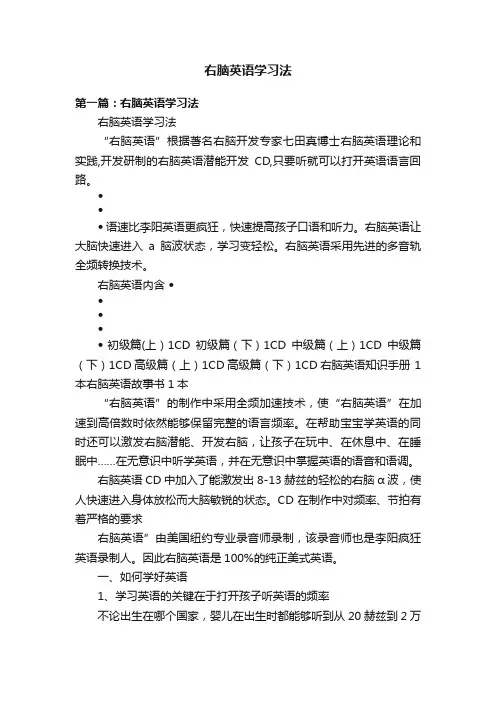
右脑英语学习法第一篇:右脑英语学习法右脑英语学习法“右脑英语”根据著名右脑开发专家七田真博士右脑英语理论和实践,开发研制的右脑英语潜能开发CD,只要听就可以打开英语语言回路。
•••语速比李阳英语更疯狂,快速提高孩子口语和听力。
右脑英语让大脑快速进入a脑波状态,学习变轻松。
右脑英语采用先进的多音轨全频转换技术。
右脑英语内含•••••初级篇(上)1CD初级篇(下)1CD中级篇(上)1CD中级篇(下)1CD高级篇(上)1CD高级篇(下)1CD右脑英语知识手册 1本右脑英语故事书1本“右脑英语”的制作中采用全频加速技术,使“右脑英语”在加速到高倍数时依然能够保留完整的语言频率。
在帮助宝宝学英语的同时还可以激发右脑潜能、开发右脑,让孩子在玩中、在休息中、在睡眠中……在无意识中听学英语,并在无意识中掌握英语的语音和语调。
右脑英语CD中加入了能激发出8-13赫兹的轻松的右脑α波,使人快速进入身体放松而大脑敏锐的状态。
CD在制作中对频率、节拍有着严格的要求右脑英语”由美国纽约专业录音师录制,该录音师也是李阳疯狂英语录制人。
因此右脑英语是100%的纯正美式英语。
一、如何学好英语1、学习英语的关键在于打开孩子听英语的频率不论出生在哪个国家,婴儿在出生时都能够听到从20赫兹到2万赫兹的所有声音,各国语言都有各自不同的“优势频率带”和音域,其他音域的声音只居于次要地位。
当孩子的耳朵、大脑和听觉中枢已完全适应了母语的听和说时,对未知的声音就会难以听进去。
这是英语与汉语的最大差异,也是造成孩子学习英语困难的真正原因。
不会说英语只是因为我们耳朵听声音的能力还没有被打开。
学习语言时语法固然重要,但训练自己能正确地听清楚和说出英语的能力,培养良好的听觉才是孩子学好英语的关键。
世界各国语言都具有不同的声音频率,因此说话时产生的振动音也各不相同。
汉语是频率在2000赫兹以下的低频率语言,而英语则是在2000赫兹以上的高频率语言。
这两种语言所处的频率带完全不同。
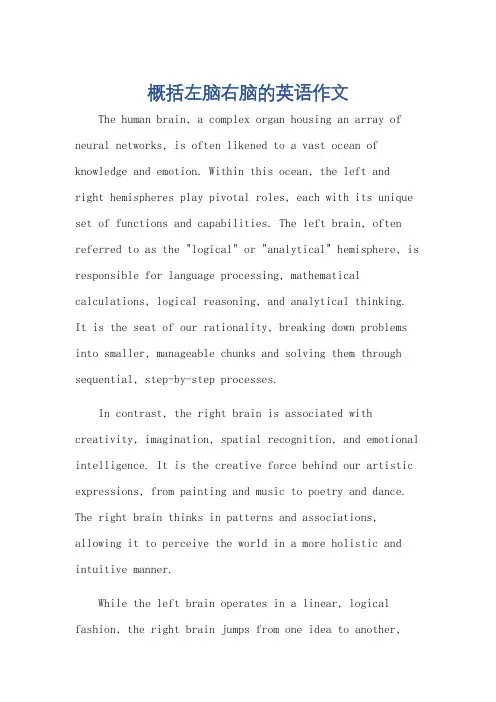
概括左脑右脑的英语作文The human brain, a complex organ housing an array of neural networks, is often likened to a vast ocean of knowledge and emotion. Within this ocean, the left andright hemispheres play pivotal roles, each with its unique set of functions and capabilities. The left brain, often referred to as the "logical" or "analytical" hemisphere, is responsible for language processing, mathematical calculations, logical reasoning, and analytical thinking. It is the seat of our rationality, breaking down problems into smaller, manageable chunks and solving them through sequential, step-by-step processes.In contrast, the right brain is associated with creativity, imagination, spatial recognition, and emotional intelligence. It is the creative force behind our artistic expressions, from painting and music to poetry and dance. The right brain thinks in patterns and associations, allowing it to perceive the world in a more holistic and intuitive manner.While the left brain operates in a linear, logical fashion, the right brain jumps from one idea to another,connecting dots that the left brain might overlook. This complementary nature of the two hemispheres is what makes us human: capable of both rational thinking and creative expression.The division of labor between the left and right brain is not absolute, however. While each hemisphere has its specialized functions, they are interconnected and reliant on each other for optimal performance. In fact, many cognitive tasks require the协同合作 of both hemispheres. For instance, when solving a complex problem, we might start with the left brain's analytical approach, but ultimately need the right brain's creativity to find a truly innovative solution.In today's world, where problem-solving and innovation are paramount, it's crucial to develop both hemispheres of the brain. While the left brain ensures we have the skills and knowledge to tackle day-to-day tasks, the right brain propels us forward with its boundless creativity and imagination. By harnessing the power of both hemispheres, we can unlock our full potential and contribute to a more innovative and compassionate society.**左右脑的奥秘**人类的大脑是一个复杂的器官,其中包含了大量的神经网络,经常被比作充满知识和情感的广阔海洋。
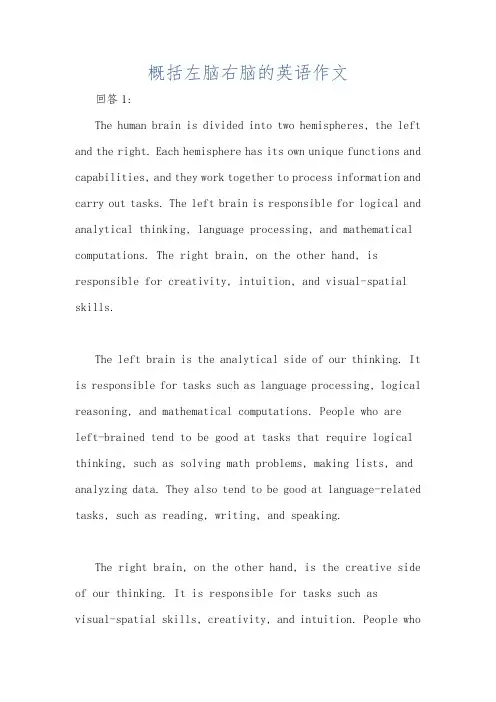
概括左脑右脑的英语作文回答1:The human brain is divided into two hemispheres, the left and the right. Each hemisphere has its own unique functions and capabilities, and they work together to process information and carry out tasks. The left brain is responsible for logical and analytical thinking, language processing, and mathematical computations. The right brain, on the other hand, is responsible for creativity, intuition, and visual-spatial skills.The left brain is the analytical side of our thinking. It is responsible for tasks such as language processing, logical reasoning, and mathematical computations. People who areleft-brained tend to be good at tasks that require logical thinking, such as solving math problems, making lists, and analyzing data. They also tend to be good at language-related tasks, such as reading, writing, and speaking.The right brain, on the other hand, is the creative side of our thinking. It is responsible for tasks such asvisual-spatial skills, creativity, and intuition. People whoare right-brained tend to be good at tasks that require creative thinking, such as art, music, and writing. They also tend to be good at visual-spatial tasks, such as reading maps and assembling puzzles.Despite the fact that the left and right hemispheres have their own unique functions, they work together to process information and carry out tasks. For example, when we read a book, the left hemisphere processes the language and the right hemisphere processes the visual images. Both hemispheres work together to create a complete understanding of the story.In conclusion, the left and right hemispheres of the brain have their own unique functions and capabilities, but they work together to process information and carry out tasks. Understanding the differences between the two hemispheres can help us to better understand how we process information and how we can improve our cognitive abilities.人类的大脑分为左脑和右脑两个半球。
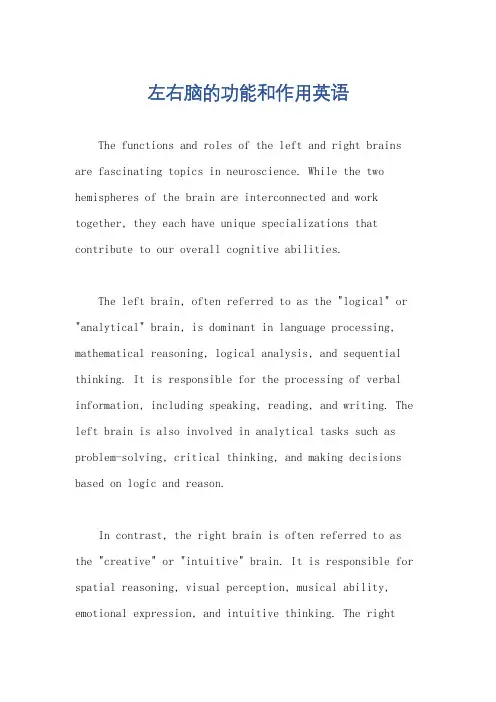
左右脑的功能和作用英语The functions and roles of the left and right brains are fascinating topics in neuroscience. While the two hemispheres of the brain are interconnected and work together, they each have unique specializations that contribute to our overall cognitive abilities.The left brain, often referred to as the "logical" or "analytical" brain, is dominant in language processing, mathematical reasoning, logical analysis, and sequential thinking. It is responsible for the processing of verbal information, including speaking, reading, and writing. The left brain is also involved in analytical tasks such as problem-solving, critical thinking, and making decisions based on logic and reason.In contrast, the right brain is often referred to as the "creative" or "intuitive" brain. It is responsible for spatial reasoning, visual perception, musical ability, emotional expression, and intuitive thinking. The rightbrain excels at processing nonverbal information and is involved in tasks such as art, music, and emotional expression. It is also responsible for our ability to perceive and understand the world through spatial relationships and patterns.While the left and right brains have distinct functions, they work together to form a complete cognitive system. The two hemispheres are connected by a bundle of nerves called the corpus callosum, which allows for communication and cooperation between the two sides. This communication is essential for many cognitive tasks, as it allows for the integration of information processed by both hemispheres.In summary, the left brain is dominant in logical, analytical, and sequential thinking, while the right brain excels at creative, intuitive, and spatial reasoning. Both hemispheres work together to form a complete cognitive system that enables us to perceive, understand, andinteract with the world in a全面 and multifaceted way.The left brain's specialization in language processingallows us to communicate effectively with others, express our thoughts and ideas, and understand complex concepts through words. Its role in mathematical reasoning and logical analysis enables us to solve problems, make informed decisions, and reason through complex scenarios. The left brain is also responsible for our ability to sequence events and experiences in a meaningful way, allowing us to organize our thoughts and actions effectively.On the other hand, the right brain's specialization in spatial reasoning and visual perception enables us to perceive and understand the world through spatial relationships and patterns. Its role in musical ability allows us to appreciate and create music, while its involvement in emotional expression enables us to convey and understand emotional states. The right brain is also responsible for our ability to generate new ideas and solutions through intuitive thinking and creativity.The integration of information processed by both hemispheres is crucial for many cognitive tasks. Forexample, when we read a book, the left brain processes the words and sentences, while the right brain contributes to our understanding of the story's emotional and visual elements. Similarly, when we solve a complex problem, the left brain analyzes the logic and facts, while the right brain generates new ideas and perspectives.In conclusion, the left and right brains play complementary roles in our cognitive abilities. The left brain excels at logical, analytical, and sequential thinking, while the right brain specializes in creative, intuitive, and spatial reasoning. By working together, these two hemispheres enable us to perceive, understand, and interact with the world in a rich and multifaceted way.。

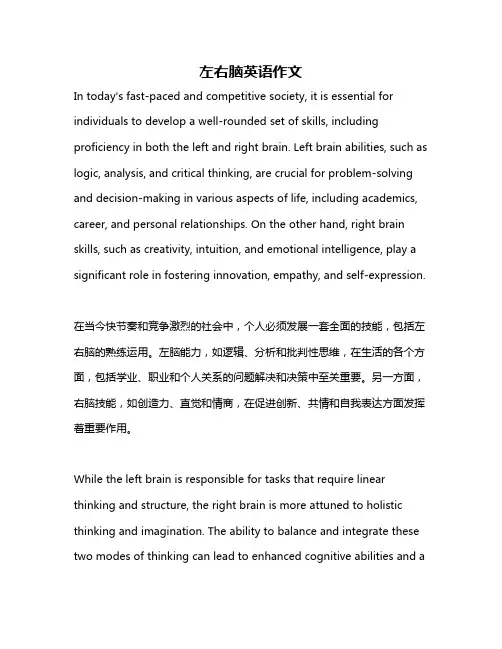
左右脑英语作文In today's fast-paced and competitive society, it is essential for individuals to develop a well-rounded set of skills, including proficiency in both the left and right brain. Left brain abilities, such as logic, analysis, and critical thinking, are crucial for problem-solving and decision-making in various aspects of life, including academics, career, and personal relationships. On the other hand, right brain skills, such as creativity, intuition, and emotional intelligence, play a significant role in fostering innovation, empathy, and self-expression.在当今快节奏和竞争激烈的社会中,个人必须发展一套全面的技能,包括左右脑的熟练运用。
左脑能力,如逻辑、分析和批判性思维,在生活的各个方面,包括学业、职业和个人关系的问题解决和决策中至关重要。
另一方面,右脑技能,如创造力、直觉和情商,在促进创新、共情和自我表达方面发挥着重要作用。
While the left brain is responsible for tasks that require linear thinking and structure, the right brain is more attuned to holistic thinking and imagination. The ability to balance and integrate these two modes of thinking can lead to enhanced cognitive abilities and agreater capacity for innovation and creativity. By cultivating both sides of the brain, individuals can become more adaptable and better equipped to navigate the complexities of the modern world.左脑负责需要线性思维和结构的任务,而右脑更注重整体性思维和想象力。

右脑英语学习的十个重点1.从整体到个体右脑不是通过积累个体而理解整体,而是以对整体的把握为前提,通过个体在整体中的作用对其进行理解右脑不苛求理解,只需大量、快速、反复地输入信息即可启动。
2.不要苛求完美苛求完美是右脑式英语学习的大敌。
语法和意思稍有不清楚没关系,反复朗读、背诵、继续下一环节。
反复背诵最重要。
3.学习“用得上”的英语11英美人的日常会话中,常用的2000个基本词占93、5%。
在学习高难度的表达法之前,先掌握最基本的用法。
为了应付考试所学习的英语不一定真正“用得上”。
4、英语不是“学问”,而是“技能”勤练习、多体会,一定可以熟能生巧,掌握最低限度的语法规则是必要的,练习通过“声音‘来进行交流,我们要通过听(耳朵繁荣训练)和说(嘴皮的训练)真正地掌握英语。
5、必须保证“输入量”再长的文章也是由一个个短句构成的(最有效2000个基本词组成的短句),大量22记忆短句,通过反复朗读,在右脑中“刻录”英语句型。
多阅读包含2000个基本单词的书籍,加强记忆。
6、高速记忆激发图象联想大量快速的输入可以激发右脑,提高右脑的图象联想能力。
图象联想能力一旦养成,即刻就能记忆大量单词。
7、把单词和文章图像化通过图像来把握单词的基本含义。
8、开口发声,培养即时反应能力3个步骤:朗读、在最短的时间内复述对方的话、翻译。
(翻译训练可在背诵训练之后进行。
)想要说出流利的英语,33就需要反复练习,直到从有意识记忆到无意识脱口而出。
反复听已经弄懂了意思的单词和文章,朗读、跟读、背诵。
翻译训练,在瞬间把图像转换为声音。
9、关键的一环:让你的耳朵也来熟悉英语。
每天听语速快的英语,早日突破音频障碍,美英1000-3000赫兹,英式应:2000-13000,从早到晚,以比正常速度快2-4倍的速度听英语,用不了3个月,耳朵就可以适应英语了。
听惯了高速英语(语速极快的英语),正常语速的英语就不在话下了。
4410、最好的学习方法:出声朗读学习语言要重视输入,而不仅仅是对话。
